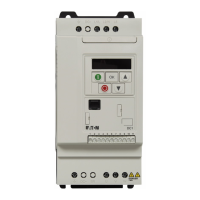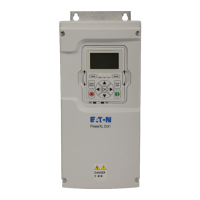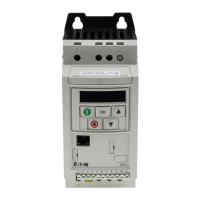2 Engineering
2.5 Motor
DC1 variable frequency drive 12/13 MN04020003Z-EN www.eaton.com 39
2.5.4 87-Hz Characteristic curve
The three-phase motor with the rating plate in Figure 14 can be operated
with either a star or delta circuit. The operational characteristic curve is deter-
mined by the ratio of motor voltage to motor frequency in this case.
The 87-Hz characteristic curve is used to operate the three-phase standard
motor with the rating plate in Figure 14 with a delta circuit on a 400-V
network at 87 Hz. To enable this, the variable frequency drive must deliver
the higher current for delta circuits (3.2 A) and the motor frequency (V/Hz key
point) must be set to 87 Hz on the variable frequency drive.
This results in the following advantages:
• The motor's speed adjustment range is increased by a factor of 3 (from
50 Hz to 87 Hz)
• The motor's efficiency is improved, since the motor speed increases
while the (absolute) slip remains the same and therefore is smaller,
percentage-wise, relative to the new (higher) speed
• Greater power can be taken from the motor (P ~ M x n), making it
possible in some cases to use a motor that is one size smaller (and
therefore less expensive) for the application (e.g., travel motor in crane
drives)
• The machine speed of existing machines can be increased without
having to change the motor and/or transmission. In other words, opera-
tion does not take place within the field-weakening range
Figure 16: V/Hz characteristic curve for the rating plate of the motor from Figure 14
a Star connection: 400 V, 50 Hz
b Delta circuit: 230 V, 50 Hz
c Delta connection: 400 V, 87 Hz
→
Due to the higher thermal load, it is recommended to only use
the next higher listed motor output.
→
If using 2 pole motors (p = 1), the high speed of approximately
5,000 rpm must be taken into account (consult the manufac-
turer's specifications).
0
8750
400
U
2
[V]
f [Hz]
f
max
230
ac
b

